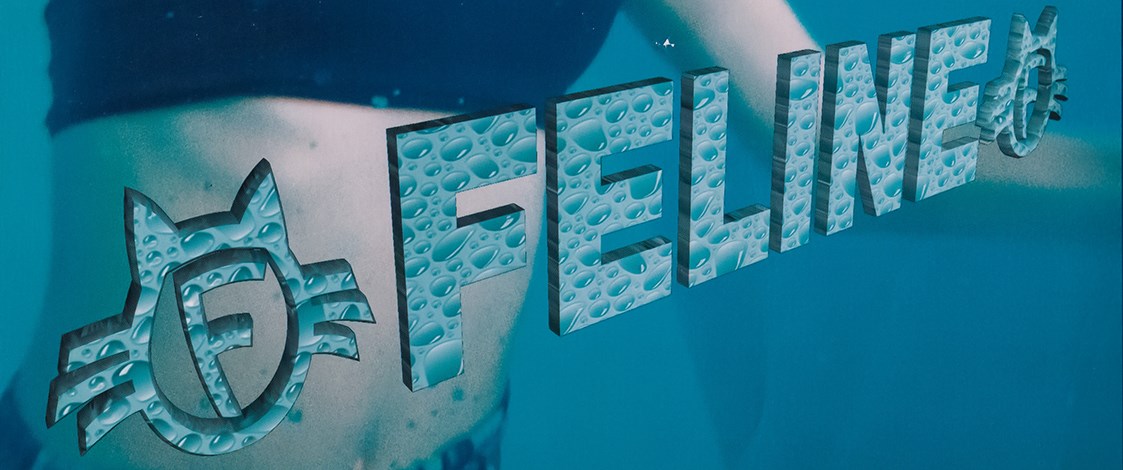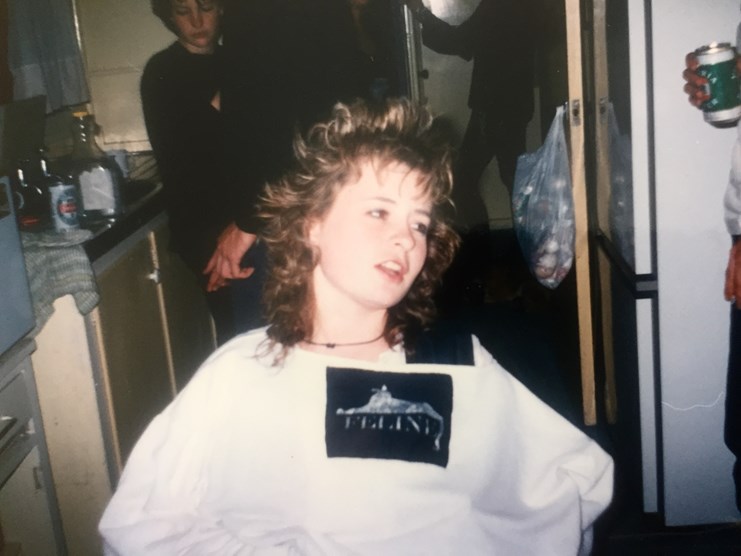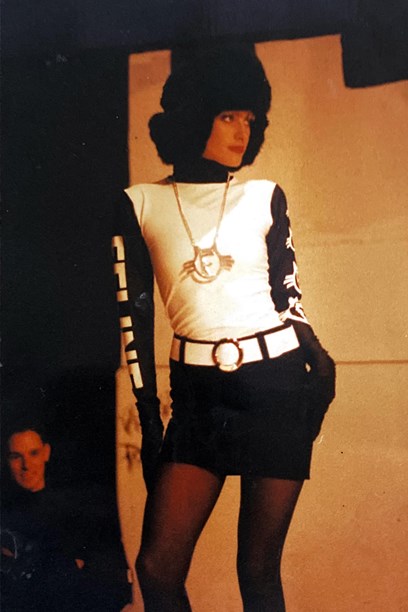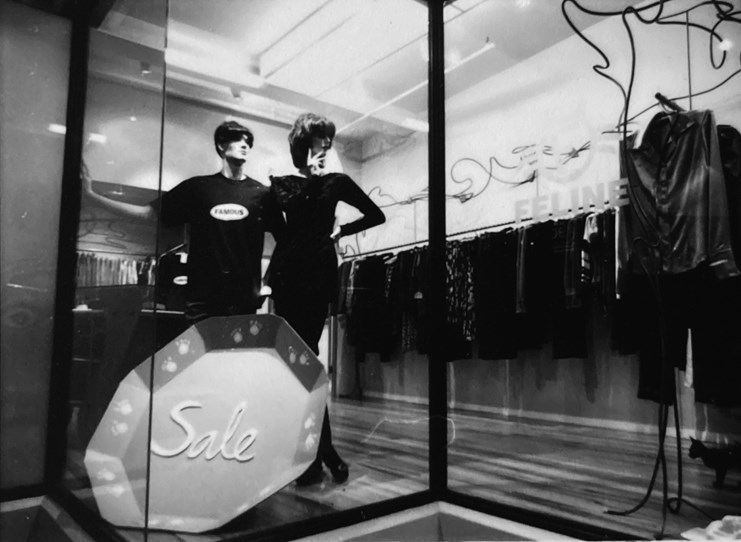Stories
Feline
1986-2007

During the 1980s and 1990s, the face of central Auckland was changing radically as heritage buildings were demolished and replaced by corporate tower blocks. While the glossy new buildings had their street frontages tenanted with international fashion retail brands, Tanya Sheridan and Andrew Bishop were part of a staunch local industry who banded together to showcase New Zealand fashion. Designing under the label, Feline, they were an active part of the High Street fashion district for more than 20 years.
In the early 1980s Tanya Sheridan was studying fashion at Auckland Institute of Technology and, like many of her contemporaries, making an income by selling her designs at the Cook Street Market where she shared a stall with her sister Linda and a friend Katherine Widdas. Tanya remembers "at that time, my style was my take on the post punk style of Vivienne Westwood, the new romantic culture of dressing to excess and the new silhouettes and fabric-led design coming from Japan."
After completing her diploma, Tanya started part time work and later became the manager of the super hip Blue Beat store in Bledisloe Lane. It was at Blue Beat, working with owner Leone Batchelor and Leone's sister Melodie that Tanya learnt the fashion retail trade and acquired the skills that would prove invaluable when she was to establish her own business.
Meanwhile her partner Andrew Bishop was also earning an income working as Station Manager at Campus Radio 95bFM while studying architecture at Auckland University, but it was the knowledge he gained through his next job at Snow Rainger Textiles that would stand him in good stead when it came to establishing Feline.

Tanya Sheridan and Andrew Bishop started the Feline label in 1987. Image © Feline.
When Cook Street Market closed in December 1985, Tanya moved to the Nelson Street Market, juggling her work at Blue Beat with making and selling her own designs on the weekends. Drawing on Andrew’s textile knowledge and connections, Tanya expanded her range and their fashion label 'Feline' was born.

Greer Monkley wearing one of Feline’s first branded sweatshirts, which she purchased from their Nelson Street Market stall in 1986. Image © Blake Monkey.
In 1987 Tanya and Andrew were offered a retail space in the walkway between Durham Lane and Wyndham Street. The shop was owned by the late Les Harvey, a property owner who had restored many of the heritage buildings in Parnell during the 1970s and developed the Parnell Village. Tanya worked in the shop, sewing in between serving customers. Feline’s range of made-to-measure businesswear attracted a number of women who worked for the New Zealand Herald, which was located around the corner on Albert Street. Their support of the label in turn led to considerable coverage in that newspaper, including photoshoots and editorial by their new fashion editor, Susan Axford.
Although their own landlord vehemently opposed the destructive redevelopment of the CBD, many of the buildings surrounding them were demolished including His Majesty’s Theatre at the end of 1987 and Brown’s Mill in 1988. Wyndham Street was a never ending construction site - not an ideal location for a workroom and fashion retail store. "When they started pulling down all the buildings around us it got really grim. The stock market had crashed and it was a pretty tough time," Andrew recalls.
In 1989 Tanya and Andrew moved out of Wyndham Street and into a store in the Century Arcade at 5 High Street. They shared the space with The Cutter of Newton, which was owned by Former Screaming MeeMee Mike O’Neill, who worked with his sisters Sharee and Erin. They designed menswear, and although they sold some of Karen Walker’s early designs, Feline’s womenswear was a welcome addition to the store. When Feline first started in High Street there were very few branded streetwear labels and early ranges were designed to be worn during the day and then mixed up to go out for the night.

Feline top, skirt and rabbit hat. Image © Feline.
Initially the shop remained under The Cutter of Newton signage and with a staff member employed to look after the shop, Tanya had more time for design and sewing. She set up a workroom from home and Andrew left his job at Snow Rainger to focus on expanding the business.
The Century Arcade was a hub for independent designer fashion retail. Street Life occupied the streetfront store and later that year WORLD opened their first store there. After about six months, the O’Neills decided they were going to close their share of the business as they were involved in other endeavours and didn’t have the time to continue on.
Although Tanya and Andrew were worried about taking on the responsibility of the entire space (and the entire rent), they decided to take the plunge and expand Feline. Tanya employed a patternmaker and they increased their output. They also invited friends from the Cook Street Market days, Sam Grey and Linz Ariell, to sell their menswear label Marvel in the store. Linz recalls, "They were the cool cats. Young and very very cool. Tanya wore white foundation and had jet black hair. So hip. Andrew was DJing a regular gig on 95bFM and was celebrated in the music scene."
In 1990 Feline also started producing a small range of branded menswear in response to customer demand. Many garments from this range became unisex or were duplicated into women’s fits.
Feline menswear modelled by Adam Puttick and Damian Cross. Image © Feline.
They painted the space and re-opened the store as Feline in mid 1990. Luckily it was an immediate success. "After our first Christmas in High Street, and because everything was cash and we’d never had so much money in our lives, we threw it on the bed and jumped on it,” Andrew recalls. Six years later Feline moved their business to the streetfront shop when Street Life moved out. The Century Arcade was to be their home for more than two decades.

The Feline store front in 1996. Image © Feline.
The 1990s were a dynamic time for New Zealand fashion. The fashion magazine industry was thriving with glossy mainstream magazines such as Fashion Quarterly and More as well as more fringe publications like Planet and Pavement. Televised fashion showcases such as the Wella Fashion Collections brought the new seasons local fashion into every lounge in the country while success in the Benson & Hedges Fashion Design Awards could turn previously unknown designers into household names.
Magazine ads for Feline. Image © Feline.
Feline’s path to success followed an alternate route. "We didn’t enter the Benson & Hedges awards as it wasn’t really our idea of fashion," Andrew explains. We didn’t agree with the concept of a fashion competition, and believed that for a label the only competition that mattered was at the cash register. To us, making a frock out of cardboard or 30,000 bottle-tops had nothing to do with fashion." They did however make a cameo appearance in the show when musician Dianne Swann of When the Cat's Away was invited to present an award. "Dianne was working part time in our shop and when she told us she was going to present an award, we made her an outfit that was a hooded top and hot pants branded with a large sequinned Feline logo across the chest."
Tanya and Andrew chose instead to focus on their own shows, which at times were held as often as once a week. "We started doing joint club shows like Overdrive which were organised by Jo Mikelborough, Andrew Tidball and Shane O’Neill. We’d show as part of a group of designers - a series of mini shows within a big show - with the clothes worn on stage by models and dancers."

Feline and Marvel designs on the catwalk. Image © Feline.
The shows grew to become more theatrical. In one show with Marvel, in the early 1990s, which was held at Don’t Tell Mama on Karangahape Road, the models emerged from a two-storey cardboard cat castle.
Feline show at Don't Tell Mama. Images © Feline.
Tanya and Andrew continued their love of creating theatrical shows when they took part in New Zealand Fashion Week in the early 2000s. They had a Cluedo theme where the models were dressed as the characters from the board game. Miss Scarlett wore a red halter neck cocktail dress, while Colonel Mustard had on a black business suit and a denim trench coat. The stage was set as an English country house interior and the range saw the release of an enormously successful range of dresses and suits made with english printed florals.
Another novel approach they developed was to hire a bus and do impromptu shows in cafes all over New Zealand. The models would parade through the cafe and hand out flyers. "We sold more clothes after our fashion shows than we did from any other form of promotion," Andrew says.

Early 90s fashion show. Image © Feline.
Feline had wanted to show as part of the New Zealand contingent at Australian Fashion Week in 1997, but despite the success of their shows, they weren’t selected. "It was disappointing," Andrew says, "as we were putting together incredible shows and we believed we would have shone on the international fashion stage."
Undeterred, Tanya and Andrew wholesaled their Feline label in stores all over New Zealand and Australia selling ranges of denim and heavily-branded club and streetwear. They designed all their own graphics and garment prints, often collaborating with many early digital artists including Mike Riley (Kids on E), Ross George (xCode), Chapman Designs, Outer Aspect and Amy Neave.

Feline jacket with print by Mike Riley (Kids on E). Image © Feline.
A big hit with customers were Feline’s hand-drawn carry bags, several of which were part of the recent Carried Away bag exhibition at the Auckland Museum.
Hand-drawn Feline carry bags, courtesy of of Auckland Museum Tāmaki Paenga Hira, 2002.46.1 and 2003.23.2.
They also designed costumes for the band Supergroove in 1993. Andrew recalls that they were approached by the band manager, Stuart Broughton, to create a uniform look for Supergroove. The white, red and black colour scheme came from Karl Steven and had been captured in the band logo designed by Ben Sciascia. "The scope of the commission blossomed," Andrew says, "when we realised the size of the band, multiplied by four pieces each, multiplied by the fact that they all wanted to be uniform but unique." Feline ended up making 32, custom-printed garments that featured in their 1994 video 'You Gotta Know'. Nick Atkinson remembers, "We were each presented with pieces of paper with the garment outlines printed on. We could choose where the logos went and which colour each panel would be. It was a lot of fun. There was much debate about colour schemes, but everybody had pretty strong ideas about how they wanted their outfit to look. Not too long ago I ran into an old buddy who worked at Marbeck's at the time and he and all the staff were apparently very impressed when we walked into the shop sporting our custom, personalised Feline tracksuits. They were bold and unique. They made us feel ten feet tall on stage too."
In 2003 the owner of the Century Arcade building abruptly ended the leases of all the tenants. Tanya and Andrew found a new space in O’Connell Street, opposite Vulcan Lane, in a shop that had been home to Kevin Berkhan in the 1980s. Still located within the High Street District, they remained part of a thriving fashion community with Adrienne Winkelmann and Zambesi occupying neighbouring stores.
When their son Rex was born in 2006, and after a protracted high court dispute with the owner of the O’Connell Street store ended in a stalemate, Tanya and Andrew moved the Feline store to Ponsonby. After the stress of the court battle the gloss had worn off and in 2007 they decided to close the label. Andrew stayed in the industry and went to work for Adrienne Winkelmann and later for Crane Brothers.
In 2017 they decided to revive the label as a side project, making t-shirts with the Feline label and made-to-measure designs to commission.
Text by Kelly Dix. Banner image design by Andrew Bishop, Ross George, Chapman Design and Karl Pierard. Image © Feline.
Published April 2021.